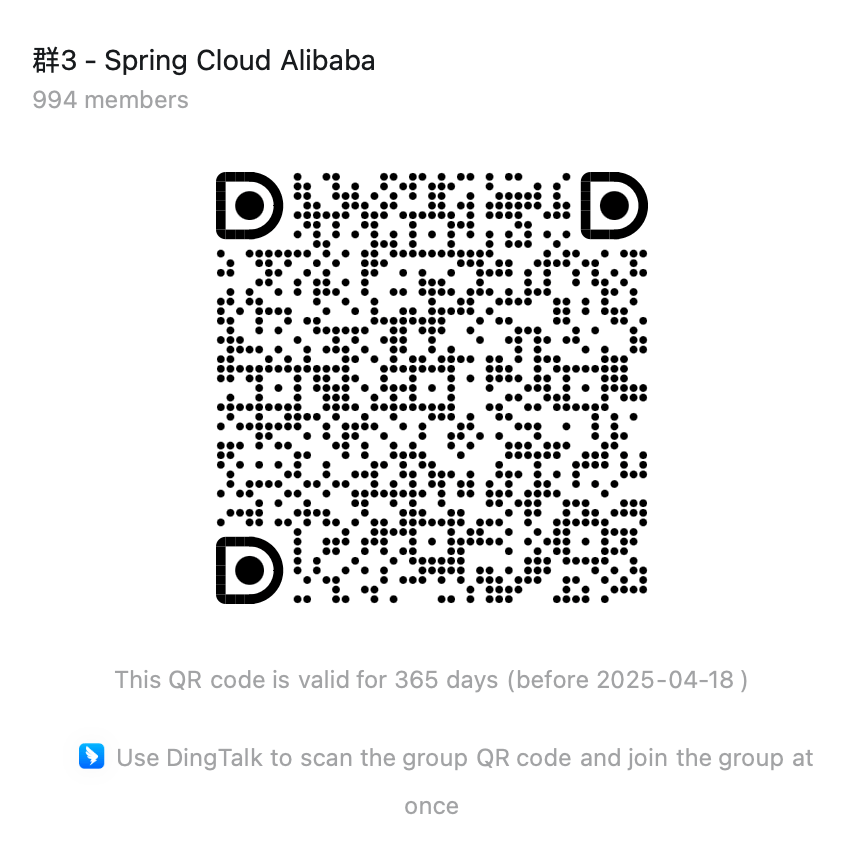快速开始
快速开始
本节主要演示如何使用 spring-cloud-starter-alibaba-governance-routing 模块完成标签路由功能:
组件支持说明
目前,路由模块只支持了部分组件:
远程调用组件:Spring Cloud OpenFeign
负载均衡组件:Ribbon
未来会支持更多的比如 RestTemplate,Spring Cloud LoadBalancer 等组件。
示例
如何接入
注意 本章节只是为了便于您理解接入方式,本示例代码中已经完成接入工作,您无需再进行修改。
- 首先,修改需要进行路由服务的 pom.xml 文件,引入
spring-cloud-starter-alibaba-governance-routing依赖。
<dependency> <groupId>com.alibaba.cloud</groupId> <artifactId>spring-cloud-starter-alibaba-governance-routing</artifactId></dependency>- 配置当没有路由规则时的负载均衡算法(以随机负载均衡算法为例)如果没有配置,使用 Ribbon 默认的负载均衡算法 ZoneAvoidanceRule
spring.cloud.governance.routing.rule=RandomRule应用启动
启动以下三个模块的启动类,分别为 ConsumerApplication ,两个 ProviderApplication ,将其注入到 Nacos 注册中心中。
效果演示
规则说明
实例中设置的规则如下:
@GetMapping("/add")public void getDataFromControlPlaneTest() { List<RouteRule> routeRules = new ArrayList<>(); List<MatchService> matchServices = new ArrayList<>(); UnifiedRouteDataStructure unifiedRouteDataStructure = new UntiedRouteDataStructure(); unifiedRouteDataStructure.setTargetService("service-provider"); LabelRouteRule labelRouteData = new LabelRouteRule(); labelRouteData.setDefaultRouteVersion("v1"); RouteRule routeRule = new HeaderRule(); routeRule.setType("header"); routeRule.setCondition("="); routeRule.setKey("tag"); routeRule.setValue("v2"); RouteRule routeRule1 = new UrlRule.Parameter(); routeRule1.setType("parameter"); routeRule1.setCondition(">"); routeRule1.setKey("id"); routeRule1.setValue("10"); RouteRule routeRule2 = new UrlRule.Path(); routeRule2.setType("path"); routeRule2.setCondition("="); routeRule2.setValue("/router-test"); routeRules.add(routeRule); routeRules.add(routeRule1); routeRules.add(routeRule2); MatchService matchService = new MatchService(); matchService.setVersion("v2"); matchService.setWeight(100); matchService.setRuleList(routeRules); matchServices.add(matchService); labelRouteData.setMatchRouteList(matchServices); unifiedRouteDataStructure.setLabelRouteRule(labelRouteData); List<UntiedRouteDataStructure> unifiedRouteDataStructureList = new ArrayList<>(); unifiedRouteDataStructureList.add(unifiedRouteDataStructure); controlPlaneConnection.pushRouteData(unifiedRouteDataStructureList);}代码对应的规则如下:
若同时满足请求参数中含有 tag=v2 ,请求头中含有 id 且值小于 10,uri 为 /router-test 则流量全部路由到 v2 版本中,若有一条不满足,则流量路由到 v1 版本中。
规则也支持动态修改,测试动态修改的规则如下:
@GetMapping("/add")public void getDataFromControlPlaneTest() { List<RouteRule> routeRules = new ArrayList<>(); List<MatchService> matchServices = new ArrayList<>(); UntiedRouteDataStructure unifiedRouteDataStructure = new UntiedRouteDataStructure(); unifiedRouteDataStructure.setTargetService("service-provider"); LabelRouteRule labelRouteData = new LabelRouteRule(); labelRouteData.setDefaultRouteVersion("v1");
RouteRule routeRule = new HeaderRule(); routeRule.setType("header"); routeRule.setCondition("="); routeRule.setKey("tag"); routeRule.setValue("v2"); RouteRule routeRule1 = new UrlRule.Parameter(); routeRule1.setType("parameter"); routeRule1.setCondition(">"); routeRule1.setKey("id"); routeRule1.setValue("10");
RouteRule routeRule2 = new UrlRule.Path(); routeRule2.setType("path"); routeRule2.setCondition("="); routeRule2.setValue("/router-test"); routeRules.add(routeRule); routeRules.add(routeRule1); routeRules.add(routeRule2);
MatchService matchService = new MatchService(); matchService.setVersion("v2"); matchService.setWeight(50); matchService.setRuleList(routeRules); matchServices.add(matchService); labelRouteData.setMatchRouteList(matchServices); unifiedRouteDataStructure.setLabelRouteRule(labelRouteData); List<UntiedRouteDataStructure> unifiedRouteDataStructureList = new ArrayList<>(); unifiedRouteDataStructureList.add(unifiedRouteDataStructure); controlPlaneConnection.pushRouteData(unifiedRouteDataStructureList);}代码对应的规则如下:
若同时满足请求参数中含有 tag=v2,请求头中含有 id 且值小于 10,uri 为 /router-test,则 50%流量路由到 v2 版本中,剩下的流量路由到 v1 版本中,若有一条不满足,则流量路由到 v1 版本中。
演示步骤
-
访问 http://localhost:18083/add 将路由规则由控制面接口推入路由规则仓库中。 访问 http://localhost:18083/router-test 不满足路由规则,路由到 v1 版本中,v1 版本实例打印返回如下结果:
Terminal window Route in 30.221.132.228: 18081,version is v1.访问 http://localhost:18083/router-test?id=11 且请求头设置 tag 值为 v2 满足路由规则,路由到 v2 版本中,v2 版本实例打印返回如下结果:
Terminal window Route in 30.221.132.228: 18082,version is v2. -
访问 http://localhost:18083/update 模拟动态修改路由规则。 访问 http://localhost:18083/router-test 不满足路由规则,路由到 v1 版本中,v1 版本实例打印返回如下结果:
Terminal window Route in 30.221.132.228: 18081,version is v1.访问 http://localhost:18083/router-test?id=11 且请求头设置 tag 值为 v2 满足路由规则,50% 路由到 v2 版本中,v2 版本实例打印返回如下结果:
Terminal window Route in 30.221.132.228: 18082,version is v2.50% 路由到 v1 版本中,v1 版本实例打印返回如下结果:
Terminal window Route in 30.221.132.228: 18081,version is v1. -
如果不推送规则,走正常路由
集成 Istio
注意 本章节只是为了便于您理解接入方式,本示例代码中已经完成接入工作,您无需再进行修改。
安装 K8s 环境
请参考 K8s 的安装工具小节。
在 K8s 上安装并启用 Istio
请参考 Istio 官方文档的安装小节。
Istio 流量治理规则介绍
配置
- 首先,修改 pom.xml 文件,引入
spring-cloud-starter-alibaba-governance-routing依赖。同时引入 Spring Cloud Alibaba 的spring-cloud-starter-xds-adapter模块
<dependency> <groupId>com.alibaba.cloud</groupId> <artifactId>spring-cloud-starter-alibaba-governance-routing</artifactId></dependency><dependency> <groupId>com.alibaba.cloud</groupId> <artifactId>spring-cloud-starter-xds-adapter</artifactId></dependency>- 在
src/main/resources/application.yml配置文件中配置 Istio 控制面的相关信息:
server: port: 18084spring: main: allow-bean-definition-overriding: true application: name: service-consumer cloud: nacos: discovery: server-addr: 127.0.0.1:8848 fail-fast: true username: nacos password: nacos governance: auth: # 是否开启鉴权 enabled: ${ISTIO_AUTH_ENABLE:false} istio: config: # 是否开启Istio配置转换 enabled: ${ISTIO_CONFIG_ENABLE:true} # Istiod ip host: ${ISTIOD_ADDR:127.0.0.1} # Istiod 端口 port: ${ISTIOD_PORT:15010} # 轮询Istio线程池大小 polling-pool-size: ${POLLING_POOL_SIZE:10} # 轮询Istio时间间隔 polling-time: ${POLLING_TIME:10} # Istiod鉴权token(访问Istiod 15012端口时可用) istiod-token: ${ISTIOD_TOKEN:} # 是否打印xds相关日志 log-xds: ${LOG_XDS:true}应用启动
启动三个模块的启动类,分别为 IstioConsumerApplication,两个 ProviderApplication,将其注入到 Nacos 注册中心中。
下发配置
通过 Istio 控制面下发标签路由规则,首先下发 DestinationRule 规则:
kubectl apply -f - << EOFapiVersion: networking.istio.io/v1alpha3kind: DestinationRulemetadata: name: my-destination-rulespec: host: sca-virtual-service subsets: - name: v1 labels: version: v1 - name: v2 labels: version: v2EOF此规则将后端服务拆分为两个版本,label 为 v1 的 pod 被分到 v1 版本,label 为 v2 的 pod 被分到 v2 版本 之后,下发 VirtualService 规则:
kubectl apply -f - << EOFapiVersion: networking.istio.io/v1alpha3kind: VirtualServicemetadata: name: sca-virtual-servicespec: hosts: - service-provider http: - match: - headers: tag: exact: v2 uri: exact: /istio-label-routing route: - destination: host: service-provider subset: v2 - route: - destination: host: service-provider subset: v1EOF这条 VirtualService 指定了一条最简单的标签路由规则,将请求头 tag 为 v2 ,请求路径为 /istio-label-routing 的 HTTP 请求路由到 v2 版本,其余的流量都路由到 v1 版本:
效果演示
发送一条不带请求头的 HTTP 请求至 IstioConsumerApplication:
$ curl --location --request GET '127.0.0.1:18084/istio-label-routing'因为请求头不为 v2,所以请求将会被路由到 v1 版本,返回如下:
Route in 30.221.132.228: 18081,version is v1.之后发送一条请求头 tag 为 v2,且请求路径为 /istio-label-routing 的 HTTP 请求:
$ curl --location --request GET '127.0.0.1:18084/istio-label-routing' --header 'tag: v2'因为满足路由规则,所以请求会被路由至 v2 版本:
Route in 30.221.132.228: 18082,version is v2.最后删除这条标签路由规则:
$ kubectl delete VirtualService sca-virtual-service$ kubectl delete DestinationRule my-destination-rule删除规则后,可以看到路由的策略将不由请求头的携带与否来决定,而是完全遵从于负载均衡器的实现。
集成 OpenSergo
注意 本章节只是为了便于您理解接入方式,本示例代码中已经完成接入工作,您无需再进行修改。
- 首先,修改 pom.xml 文件,引入
spring-cloud-starter-alibaba-governance-routing依赖。同时引入 Spring Cloud Alibaba 的spring-cloud-starter-opensergo-adapter模块
<dependency> <groupId>com.alibaba.cloud</groupId> <artifactId>spring-cloud-starter-alibaba-governance-routing</artifactId></dependency><dependency> <groupId>com.alibaba.cloud</groupId> <artifactId>spring-cloud-starter-opensergo-adapter</artifactId></dependency>- 在 application.properties 配置文件中配置 OpenSergo 控制面的相关信息
# OpenSergo 控制面 endpointspring.cloud.opensergo.endpoint=127.0.0.1:10246应用启动
启动三个模块的启动类,分别为 OpenSergoConsumerApplication,两个 ProviderApplication,将其注入到 Nacos 注册中心中。
下发配置
启动 OpenSergo 控制面 ,并通过 OpenSergo 控制面下发流量路由规则。
kubectl apply -f - << EOFapiVersion: traffic.opensergo.io/v1alpha1kind: TrafficRoutermetadata: name: service-provider namespace: default labels: app: service-providerspec: hosts: - service-provider http: - match: - headers: tag: exact: v2 route: - destination: host: service-provider subset: v2 fallback: host: service-provider subset: v1 - route: - destination: host: service-provider subset: v1EOF这条TrafficRouter 指定了一条最简单的流量路由规则,将请求头 tag 为 v2 的 HTTP 请求路由到 v2 版本,其余的流量都路由到 v1 版本。 如果 v2 版本没有对应的节点,则将流量 fallback 至 v1 版本。
效果演示
发送一条不带请求头的 HTTP 请求至 OpenSergoConsumerApplication
$ curl --location --request GET '127.0.0.1:18083/router-test'因为请求头不为 v2 ,所以请求将会被路由到 v1 版本,返回如下
Route in 30.221.132.228: 18081,version is v1.之后发送一条请求头 tag 为 v2 的 HTTP 请求
$ curl --location --request GET '127.0.0.1:18083/router-test' --header 'tag: v2'因为满足路由规则,所以请求会被路由至 v2 版本
Route in 30.221.132.228: 18082,version is v2.停止 v2 版本的 ProviderApplication 后,继续发送一条请求头 tag 为 v2 的 HTTP 请求
$ curl --location --request GET '127.0.0.1:18083/router-test' --header 'tag: v2'因为 v2 版本没有服务提供者,因此流量被 fallback 至 v1 版本。
Route in 30.221.132.228: 18081,version is v1.


